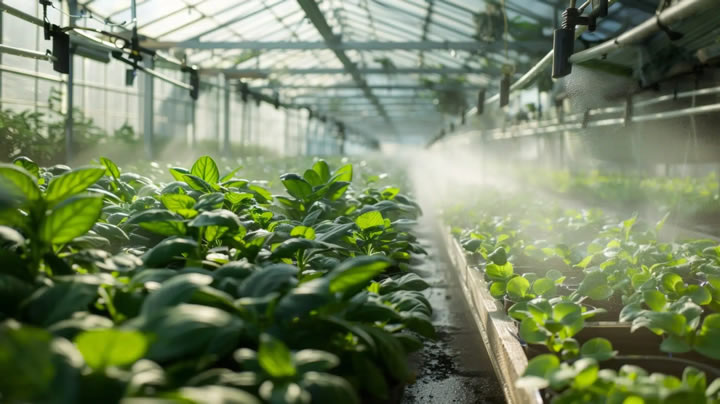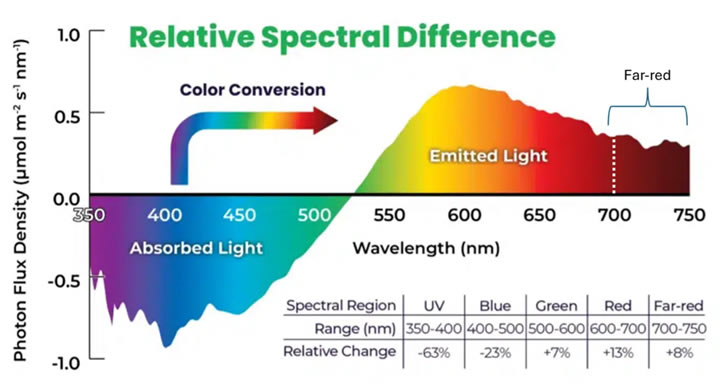The effectiveness of far-red photons in driving photosynthesis means that technologies utilizing these photons, such as downshifting luminescent materials and fixtures that include far-red, should be reevaluated for their effectiveness as plant growth spectrum providers.
 Redefining PAR: The Impact of Far-Red Photons on Photosynthesis and Horticultural Lighting
Redefining PAR: The Impact of Far-Red Photons on Photosynthesis and Horticultural Lighting

Dr. Damon Hebert, Director of Agriculture Research | UbiGro
Traditionally, photosynthetically active radiation (PAR) has been defined as the range of light wavelengths from 400 to 700 nm, based on the minimal photosynthetic activity of photons beyond 700 nm when applied alone (Emerson & Lewis, 1943; McCree, 1971). However, emerging research suggests that far-red photons (700 to 750 nm) significantly synergize photosynthesis when combined with photons within the PAR range (visible light).
This synergy indicates that far-red photons should be included in the definition of photosynthetic photons to predict photosynthesis better and evaluate the efficacy of horticultural lighting technologies. The effectiveness of far-red photons in driving photosynthesis means that technologies utilizing these photons, such as downshifting luminescent materials and fixtures that include far-red, should be reevaluated for their effectiveness as plant growth spectrum providers.
Historical Background
The wavelength dependence of photosynthesis has been long established. Early studies (Hoover, 1937; Emerson and Lewis, 1943) noted a rapid decline in photosynthetic efficiency at wavelengths above 685 nm, a phenomenon known as the “red drop” (Emerson and Lewis, 1943). Later, Emerson et al. (1957) discovered that the photosynthetic rate increased significantly when far-red photons were combined with shorter wavelengths, including red light photons, leading to the identification of the Emerson Enhancement Effect.
This effect highlighted the synergistic interaction between Photosystem I (PSI) and Photosystem II (PSII) but was largely overlooked for decades.
McCree (1972b) defined PAR as 400-700 nm based on studies using broad-spectrum horticultural lighting, without considering the potential photosynthetic contribution of far-red photons. He concluded that this range was “an acceptable definition of photosynthetic flux,” yet did not test the inclusion of far-red photons.
Recent Studies Indicate the need to Revise the Definition of PAR
Recent advancements in LED horticultural lighting technology have allowed researchers to revisit the Emerson Enhancement Effect. Zhen and van Iersel (2017) demonstrated that adding far-red photons (735 nm peak), which are crucial parts of the red light photon spectrum, to red+blue or white LEDs increased the quantum yield of PSII and leaf photosynthetic rate.
Similarly, Zhen et al. (2019) used laser diodes to show that far-red photons up to 732 nm significantly enhance photosynthetic efficiency by preferentially exciting PSI, highlighting the need to expand the traditional definition of PAR.
Further studies by Zhen and Bugbee (2020a) found that far-red photons were as effective as traditional PAR photons for photosynthesis when they comprised up to 30% of the total photon flux. They also observed that far-red photons alone were ineffective, and their benefit plateaued beyond 30% of the total flux. In a follow-up study (Zhen and Bugbee, 2020b), far-red photons were shown to maintain equal canopy quantum yield (CQY) under various LED treatments, confirming their photosynthetic value within the realm of horticultural lighting.
Challenges in Adopting the Extend PAR (ePAR) Definition
Despite compelling evidence, the Design Lights Consortium (2021) decided not to include far-red photons in the PAR definition. They cited concerns about the dependency of the enhancement effect on the spectrum of background light and misinterpreted data suggesting a non-linear photosynthetic response at higher light intensities (Zhen and van Iersel, 2017).
Zhen and Bugbee’s (2020a) research, which demonstrated that far-red photons alone had minimal photosynthetic activity but significantly enhanced photosynthesis when combined with PAR photons, was mischaracterized as merely additive. Additionally, the spectral effectiveness of far-red photons (Zhen et al., 2019) indicated that wavelengths up to 732 nm were beneficial, while those above 752 nm were not. Despite this, precise knowledge of spectral response within the PAR range has not hindered its widespread adoption, influenced by the interactions with red light photons.
Practical Implications and Future Directions
Including far-red photons in the PAR definition, termed extended PAR (ePAR), would more accurately reflect the photosynthetic activity of photons. However, the impact of far-red photons on plant morphology, such as stem and leaf elongation, suggests practical limitations to their use. Far-red photons typically cause significant elongation, likely limiting their proportion to less than 20% of the total photon flux for most crops. Therefore, LED manufacturers should clearly specify the fraction of far-red photons, including the red light photon fraction, in their fixtures.
The current definition of horticultural fixture efficacy, which excludes far-red photons, discourages innovation in lighting design. Expanding the PAR definition to ePAR (400-750 nm) would encourage the development of more efficient fixtures. As more research supports this extension, it is expected that ePAR will replace the current PAR definition, fostering advancements in horticultural lighting.

Far-Red and Downshifting Luminescent Materials for Crop Growth
Photoluminescent materials such as quantum dots, phosphors, and dyes can be used to passively downshift blue and UV parts of the sunlight spectrum to redder parts of the spectrum. This passive downshift has been shown to increase light use efficiency and yields in food crops (Hebert et al., 2022) (Parrish et al., 2021). Because passive downshifting using luminescent materials often results in a spectrum that peaks in the 600-650 nm range, the long wavelength edge can push some of the incident light past the visible light cutoff of 700 nm, into the far-red (see Figure).
The recent efforts towards a redefinition of PAR light to include far-red underscore that passive downshifting of light beyond the PAR edge can indeed be useful for photosynthesis, as long as the majority of the far-red light is provided along with a white light background, which is certainly the case for these horticultural lighting technologies.

Conclusion
In conclusion, the inclusion of far-red photons in the definition of photosynthetically active radiation (PAR) is a necessary advancement to more accurately predict photosynthetic efficiency and improve horticultural lighting design. Historical and recent studies underscore the significant role far-red photons play in enhancing photosynthesis when combined with traditional PAR wavelengths. While practical challenges such as plant morphology effects must be considered, the shift towards an extended PAR (ePAR) definition (400-750 nm) will encourage innovation and lead to more efficient horticultural fixtures.
This adjustment aligns with the increasing use of photoluminescent materials that passively downshift light into the far-red spectrum, further supporting their potential for optimizing crop growth. As research continues to validate the benefits of including far-red photons, it is expected that the industry will adopt the ePAR definition, marking a significant step forward in the field of horticultural lighting.
References
- Design Lights Consortium. (2021). [Report on the Definition of PAR].
- Emerson, R., & Lewis, C. M. (1943). Studies on the independence of photosynthesis from light intensity.
- Emerson, R., et al. (1957). Emerson Enhancement Effect.
- Hill, R., & Bendall, D. S. (1960). Function of the two photosystems in photosynthesis.
- Hebert, D., et al. (2022). Luminescent quantum dot films improve light use efficiency and crop quality in greenhouse horticulture.
- Hoover, W. H. (1937). Photosynthesis and light intensity.
- Liu, H., & van Iersel, M. W. (2021). Efficiency of red and green photons in photosynthesis.
- McCree, K. J. (1971). The action spectrum, absorptance, and quantum yield of photosynthesis in crop plants.
- McCree, K. J. (1972b). Test of current definitions of photosynthetically active radiation against leaf photosynthesis data.
- Myers, J., & Graham, J. R. (1963). The photosynthetic efficiency of far-red light.
- Parrish, C.H. (2021). Optimizing spectral quality with quantum dots to enhance crop yield in controlled environments.
- Terashima, I., et al. (2009). Green light drives leaf photosynthesis more efficiently than red light in strong white light.
- Zhen, S., & Bugbee, B. (2020a). Far-red photons have equivalent efficiency to traditional photosynthetic photons.
- Zhen, S., & Bugbee, B. (2020b). Effect of far-red light on quantum yield of photosynthesis in lettuce canopies.
- Zhen, S., et al. (2019). Effects of far-red photons on photosynthetic efficiency.
- Zhen, S., & van Iersel, M. (2017). Synergistic effects of far-red photons on photosynthesis.
The content & opinions in this article are the author’s and do not necessarily represent the views of AgriTechTomorrow
Comments (0)
This post does not have any comments. Be the first to leave a comment below.
Featured Product

